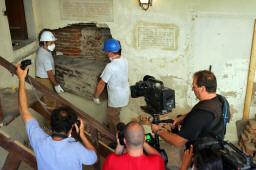Pico della Mirandola's belief that astrology was bunk may have doomed the famous model of the all-knowing 'Renaissance Man', an Italian expert says.
Pico's body was exhumed along with that of his friend, the poet Poliziano, in July to test a theory that they were poisoned.
Scientists said recently that high concentrations of arsenic had been found in the bones of both.
Silvano Vinceti, head of the national cultural committee that oversaw the exhumations, believes the humanist philosopher had angered the many exponents of astrology in Medici Florence.
He has found an anonymous letter addressed to the philosopher Marsilio Ficino, a close friend of Pico's, in which Ficino is accused of having failed to steal an anti-astrology treatise Pico was working on before his death.
Vinceti has written a book on the case, now awaiting publication.
''I believe his stance against astrology as a science may have doomed Pico. The letter angrily accuses Ficino of not getting hold of Pico's manuscript,'' Vinceti said Friday.
The treatise was eventually published, to a mixed reception, two years after Pico died within a few months of Poliziano in 1494. Ever since his untimely death at the age of 31, there has been speculation that Pico was poisoned.
At the time it was rumoured that Poliziano, 40, was also poisoned although later scholars pointed to syphilis, of which there was a Europe-wide outbreak at the time.
Both men were members of the powerful Florentine court of Lorenzo de' Medici.
The remains of the men, who were possibly lovers, were exhumed from their shared grave in a cloister of St Mark's Basilica in Florence last July.
Since their exhumation, the remains have been subjected to a battery of tests, using modern biomolecular technology, scanning equipment and DNA analyses.
In addition to identifying the cause of death, the studies have also helped experts make conjectures about the men while they were alive.
Pico's skeleton, for example, suggests he was a robust man well over six feet tall - nothing like his portraits, which depict him as fairly slender.
The studies have also shown that he suffered from a hammer toe and inflamed joints, which probably caused him stiffness.
Another interesting discovery is that Pico, who was renowned for his prodigious memory, had an extremely large head. The tests suggest his cranial capacity was 1,768 cubic centimetres, compared to an average capacity of just 1,450 cubic centimetres.
Poliziano was tiny in comparison to Pico - just five foot tall - and had a pronounced nose and problems with his neck.
The studies also revealed that the men enjoyed a diet that was rich in protein but low in fish and carbohydrates.
The remains of Poliziano and Pico, as well as the latter's friend Girolamo Benivieni, who was buried with them later, were restored to their resting place in the cloister on February 5.
However, police DNA testing is continuing on bone samples, which may uncover further secrets about the men's life and death.
A camera crew has closely followed the work of archaeologists and police involved in the project and a documentary on the exhumation and investigation will be screened on Italian TV later this year.









